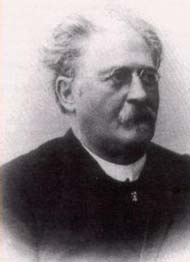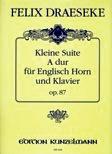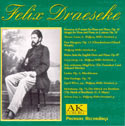Felix Draeseke: Little Suite for English Horn
and Piano, Op. 87
| Little Suite for English Horn and Piano, Op. 87 1. Menuett and Trio (Gentle minuet tempo; practically the same tempo, darkly) 2. Langsam (Slowly) 3. Ghasele (With measured movement) |
|
| Deutsche Fassung | The Little Suite for English Horn (or Oboe) and Piano, Op. 87 came into being at the end of January, the beginning of February, 1911. The suite was written for his one-time pupil, the oboist Johannes König (1890-1967), who later won highest regard among woodwind virtuosi of the 20th century. The piece also became Draeseke’s final chamber music work of his career and is apparently also the last instrumental work which he personally edited for publication. Opus 87 also indicates the last opus number in his catalog of works. Whether it is because it was intended for the English Horn or just coincidentally, this Little Suite has remained Draeseke’s most frequently republished work. If that also means his most frequently played composition, that remains for further research to reveal.
Taken as a whole this Little Suite for English Horn and Piano, Op. 87 is a highly individual work. If anyone might suggest that Draeseke became at the end of his life was a radical now become conservative, one need only to look at the three movements of this work: in his harmony and contrapuntal maneuvers Draeseke stands absolutely parallel to the most advanced ideas of a Reger, of a Mahler, of a Richard Strauss. What is encountered here in the Little Suite is experienced with even greater breadth and scope in the composer’s swansong – in the Symphonia Comica, his Fourth Symphony from the year of his death, 1913. |
| Kleine Suite für Englisch-Horn und Klavier, Op. 87 1. Menuett und Trio. Ruhiges Menuettzeitmaß; fast dasselbe Zeitmaß, düster 2. Langsam 3. Ghasele: Mäßig bewegt |
|
| Read the English version | Die Kleine Suite für Englisch Horn (oder Oboe) und Klavier, Op.87 entstand im Januar-Februar 1911 und ist also ein Spätwerk des Komponisten. Die Suite wurde für einen ehemaligen Schüler, den Oboisten Johannes König (1890-1967), geschrieben, der später zu den berühmtesten Bläservirtuosen des 20. Jahrhunderts gehörte. Das Stück bedeutete für Draeseke das endgültige Kammermusikwerk seiner musikalischen Sendung und ist augenscheinlich das letzte von ihm selbst durchgesehene Werk, das im Druck erschienen ist. Opus 87 bedeutet auch die letzte offizielle Opuszahl in seinem Werkkatalog. Ob wegen des vorgesehenen Englischhorns oder aus Zufall, bleibt diese Kleine Suite Draesekes am häufigsten nachgedrucktes Werk. Ob das auch heißt, meistgespielte Komposition, bleibt unerforscht.
Im Grossen und Ganzen ist diese Kleine Suite für Englisch-Horn und Klavier, Op. 87 ein ganz eigenartiges Werk. Wenn man es behauptet, Draeseke sei am Ende seines Lebens ein Radikaler gewesen, der Konservativer geworden sei, braucht man nur die drei Sätze dieses Werkes anzuschauen: von der Harmonik und den kontrapunktischen Gängen her steht Draeseke absolut parallel den fortschrittlichsten Gedanken eines Regers, eines Mahlers oder eines Strauß´. Was in der Kleine Suite erfahren wird, wird noch breiter und großangelegter in des Komponisten Schwanengesang erlebt -in der Symphonia Comica, seiner 4. Sinfonie aus dem Todesjahr 1913. © Alan Krueck 2003 |
| Felix Draeseke's Little Suite for English Horn on CD | |
|
Adagio for Horn and Piano, op. 31 (1885)
|
|
[Chamber Music] [Orchestral Music] [Keyboard Music] [Top]
© All contents copyright by the International Draeseke Society
 Although the most recent edition (1992) of the Little Suite maintains that the piece is in A major; right beneath this on the title page and in English there stands: Little Suite in A flat major, Op. 87 for Cor Anglais and Piano - therefore it’s in A flat major?! Misprint? Perhaps, but if so, then a multiplicity. When one looks at the sections of the movements neither A flat major nor A major occur as established keys! The first movement (Minuet, 3/4) stands in clear F major and the Trio (9/8) stays so briefly in any key that one dare not give an overall tonality. The second movement, Langsam (6/8) begins in F minor and remains there –admittedly with a brief excursion toward A major. The
Although the most recent edition (1992) of the Little Suite maintains that the piece is in A major; right beneath this on the title page and in English there stands: Little Suite in A flat major, Op. 87 for Cor Anglais and Piano - therefore it’s in A flat major?! Misprint? Perhaps, but if so, then a multiplicity. When one looks at the sections of the movements neither A flat major nor A major occur as established keys! The first movement (Minuet, 3/4) stands in clear F major and the Trio (9/8) stays so briefly in any key that one dare not give an overall tonality. The second movement, Langsam (6/8) begins in F minor and remains there –admittedly with a brief excursion toward A major. The  Obwohl die jüngste Ausgabe (1992) der Kleinen Suite behauptet, das Stück sei in A-dur geschrieben, steht gleich darunter auf der Titelseite in englischer Sprache, „Little Suite in A flat major, Op. 87 for Cor Anglais and Piano“, also in As-dur! Druckfehler? Vielleicht, aber wenn so, dann mehrere. Beim anschauen der Satzteile in der Partitur, bemerkt man weder As-dur noch A-dur als etablierte Tonarten vorkommen! Der erste Satz (Menuett, 3/4) steht in klarer F-dur und dessen Trio (9/8) verbleibt kaum lang genug in einer Tonart, sodaß man kaum etwas definitives wagen darf. Der zweite Satz, Langsam (6/8) fängt in F-moll an and verharrt dort mit –zugegeben – einem kleinen Ausflug nach A-dur. Das
Obwohl die jüngste Ausgabe (1992) der Kleinen Suite behauptet, das Stück sei in A-dur geschrieben, steht gleich darunter auf der Titelseite in englischer Sprache, „Little Suite in A flat major, Op. 87 for Cor Anglais and Piano“, also in As-dur! Druckfehler? Vielleicht, aber wenn so, dann mehrere. Beim anschauen der Satzteile in der Partitur, bemerkt man weder As-dur noch A-dur als etablierte Tonarten vorkommen! Der erste Satz (Menuett, 3/4) steht in klarer F-dur und dessen Trio (9/8) verbleibt kaum lang genug in einer Tonart, sodaß man kaum etwas definitives wagen darf. Der zweite Satz, Langsam (6/8) fängt in F-moll an and verharrt dort mit –zugegeben – einem kleinen Ausflug nach A-dur. Das 